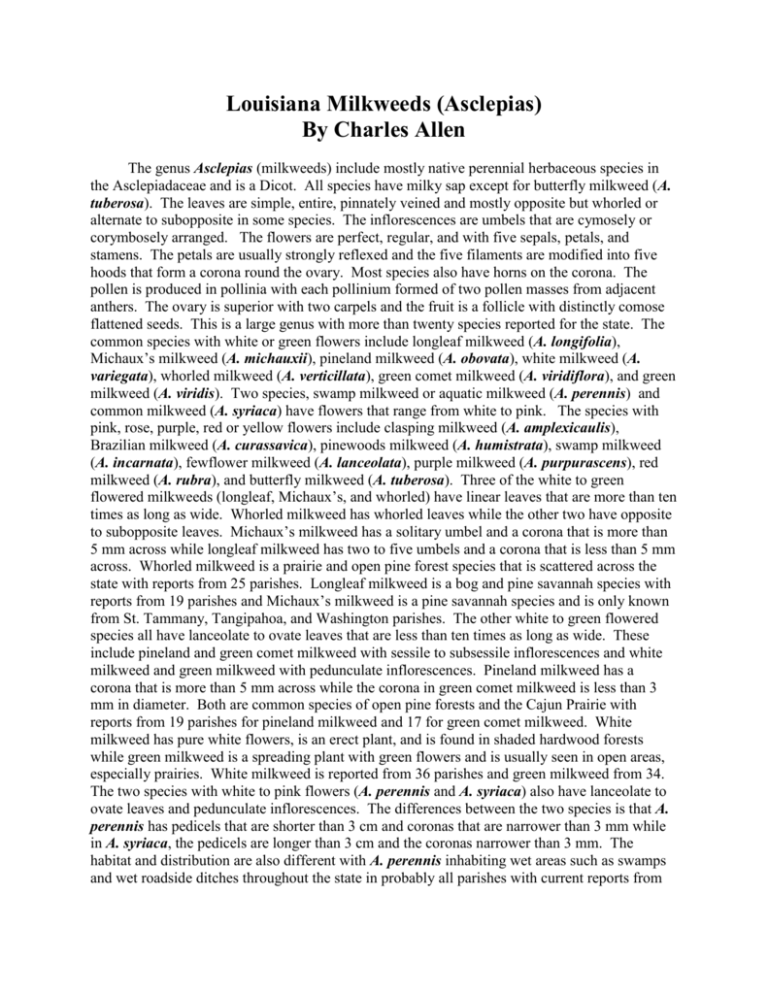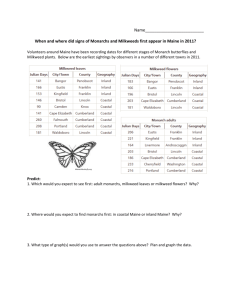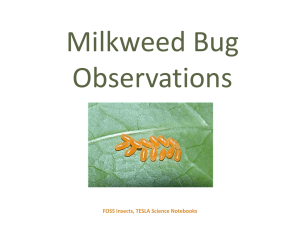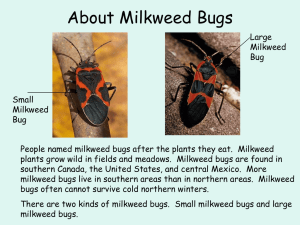The genus Asclepias (milkweeds) include mostly native perennial
advertisement

Louisiana Milkweeds (Asclepias) By Charles Allen The genus Asclepias (milkweeds) include mostly native perennial herbaceous species in the Asclepiadaceae and is a Dicot. All species have milky sap except for butterfly milkweed (A. tuberosa). The leaves are simple, entire, pinnately veined and mostly opposite but whorled or alternate to subopposite in some species. The inflorescences are umbels that are cymosely or corymbosely arranged. The flowers are perfect, regular, and with five sepals, petals, and stamens. The petals are usually strongly reflexed and the five filaments are modified into five hoods that form a corona round the ovary. Most species also have horns on the corona. The pollen is produced in pollinia with each pollinium formed of two pollen masses from adjacent anthers. The ovary is superior with two carpels and the fruit is a follicle with distinctly comose flattened seeds. This is a large genus with more than twenty species reported for the state. The common species with white or green flowers include longleaf milkweed (A. longifolia), Michaux’s milkweed (A. michauxii), pineland milkweed (A. obovata), white milkweed (A. variegata), whorled milkweed (A. verticillata), green comet milkweed (A. viridiflora), and green milkweed (A. viridis). Two species, swamp milkweed or aquatic milkweed (A. perennis) and common milkweed (A. syriaca) have flowers that range from white to pink. The species with pink, rose, purple, red or yellow flowers include clasping milkweed (A. amplexicaulis), Brazilian milkweed (A. curassavica), pinewoods milkweed (A. humistrata), swamp milkweed (A. incarnata), fewflower milkweed (A. lanceolata), purple milkweed (A. purpurascens), red milkweed (A. rubra), and butterfly milkweed (A. tuberosa). Three of the white to green flowered milkweeds (longleaf, Michaux’s, and whorled) have linear leaves that are more than ten times as long as wide. Whorled milkweed has whorled leaves while the other two have opposite to subopposite leaves. Michaux’s milkweed has a solitary umbel and a corona that is more than 5 mm across while longleaf milkweed has two to five umbels and a corona that is less than 5 mm across. Whorled milkweed is a prairie and open pine forest species that is scattered across the state with reports from 25 parishes. Longleaf milkweed is a bog and pine savannah species with reports from 19 parishes and Michaux’s milkweed is a pine savannah species and is only known from St. Tammany, Tangipahoa, and Washington parishes. The other white to green flowered species all have lanceolate to ovate leaves that are less than ten times as long as wide. These include pineland and green comet milkweed with sessile to subsessile inflorescences and white milkweed and green milkweed with pedunculate inflorescences. Pineland milkweed has a corona that is more than 5 mm across while the corona in green comet milkweed is less than 3 mm in diameter. Both are common species of open pine forests and the Cajun Prairie with reports from 19 parishes for pineland milkweed and 17 for green comet milkweed. White milkweed has pure white flowers, is an erect plant, and is found in shaded hardwood forests while green milkweed is a spreading plant with green flowers and is usually seen in open areas, especially prairies. White milkweed is reported from 36 parishes and green milkweed from 34. The two species with white to pink flowers (A. perennis and A. syriaca) also have lanceolate to ovate leaves and pedunculate inflorescences. The differences between the two species is that A. perennis has pedicels that are shorter than 3 cm and coronas that are narrower than 3 mm while in A. syriaca, the pedicels are longer than 3 cm and the coronas narrower than 3 mm. The habitat and distribution are also different with A. perennis inhabiting wet areas such as swamps and wet roadside ditches throughout the state in probably all parishes with current reports from 56 parishes while A. syriaca is a plant of disturbed areas in Lincoln, Morehouse, and Ouachita parishes. The most distinctive of the pink, rose, purple, red or yellow flowered milkweeds is butterfly milkweed (A. tuberosa) with alternate leaves and non-milky sap. It is widespread in the pine and prairie regions of the state with reports from 34 parishes. All the other species with these color of flowers have opposite leaves and include fewflower milkweed (A. lanceolata) with linear to narrowly lanceolate leaves. It is an infrequent plant of wet areas mainly in the prairie and pine flatwoods portion of the state with reports from 12 parishes. Both clasping milkweed (A. amplexicaluis) and pinewoods milkweed (A. humistrata) have sessile clasping leaves. Clasping milkweed is widespread in dry sandy soil with reports from 25 parishes while pinewoods milkweed is known only from St. Tammany and Washington parishes. Clasping milkweed is an erect plant with a solitary terminal umbel and corona that is 5 mm or wider while pinewoods milkweed is a spreading plant with two to five umbels, and a corona that is narrower than 5 mm. Both Brazilian milkweed (A. curassavica) and red milkweed (A. rubra) have glabrous to sparsely pubescent leaves while swamp milkweed (A. incarnata) and purple milkweed (A. purpurascens) have pubescent leaves. Brazilian milkweed has red to yellow flowers and is a cultivated plant that persists in southern Louisiana but takes on an annual habit in north Louisiana. Red milkweed has pink flowers and is an infrequent plant of baygalls and bogs in west central Louisiana with reports from Beauregard, Natchitoches, Rapides, and Vernon parishes. Swamp milkweed (A. incarnata) has lanceolate leaves and is a plant of the marsh with reports from Jefferson, LaFourche, St. Charles, and Terrebonne parishes while purple milkweed has ovate leaves and inhabits well-drained forests in Caldwell and Lincoln parishes. Asclepias amplexicaulis Asclepias curassavica Asclepias incarnata Asclepias longifolia Asclepias purpurascens Asclepias lanceolata Asclepias perennis Asclepias rubra Asclepias syriaca Asclepias variegata Asclepias viridiflora Asclepias tuberosa Asclepias verticillata Asclepias viridis







